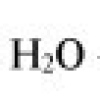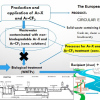Reductive degradation of biologically non-degradable trifluoromethyl aromatic contaminants in water
Technology description
| The name of the technology: | Reductive degradation of biologically non-degradable trifluoromethyl aromatic contaminants in water |
|---|---|
| Challenge: |
Halogenated aromatic compounds are generally very difficult to degrade or even non-degradable in the environment. Therefore, they occur in water as so-called micropollutants (trifluoromethyl derivatives, chloro-, bromo- and fluorine derivatives). The common method for their removal is based on adsorption onto sorbents containing activated carbon. This method leads to the purification of contaminated waters, but it results in the concentration of non-degradable micropollutants on the activated carbon. Saturated activated carbon must be incinerated as hazardous waste, and the incineration of waste is perceived very negatively by the public. Our goal was to simply chemically degrade non-degradable pollutants into products that would be easily degradable in biological wastewater treatment plants. We focused on the main sources of contamination, which is the chemical industry (pharmaceuticals and pesticides, etc.), producing process waters with high concentrations of these contaminants. |
| Description: | The technology is based on the reductive decomposition of the discussed halogenated compounds using aluminum in an alkaline environment, catalyzed by a nickel catalyst. The reaction takes place in a stirred reactor under ambient pressure and room temperature conditions. The process requires only a small excess of aluminum used as a reducing agent and allows for the recycling of the spent nickel catalyst. The products of the described process are dehalogenated and easily degradable compounds. |
| Commercial opportunity: | The technology is intended for operators of manufacturing processes involving halogenated aromatic compounds (e.g., pharmaceuticals, pesticides, etc.). Additionally, it is suitable for remediation companies and chemical wastewater treatment plants. |
| IP protection status: |
European patent Appl. No.: 21170571.0 EP3904329 (A1) CZ309733 (B6) |
| Development status: |
Phase 2Corresponds with TRL 3 and TRL 4 Feasibility study. There is a realistic design of the technology and the initial tests in the laboratory are leading to the specification of the technology requirements and its capabilities.
|
| Partnering strategy: | Collaboration licensing |
| More information: | Keywords: hydrodehalogenation, hydrodechlorination, hydrodebromination, hydrodefluorination, wastewater, liquid waste, Raney alloy, nickel recycling, water treatment, biocide degradation, PFAS. |
| Images: | |
| Categories: | Environment and Climate Chemistry |
| Owner of a technology: | Univerzita Pardubice |


